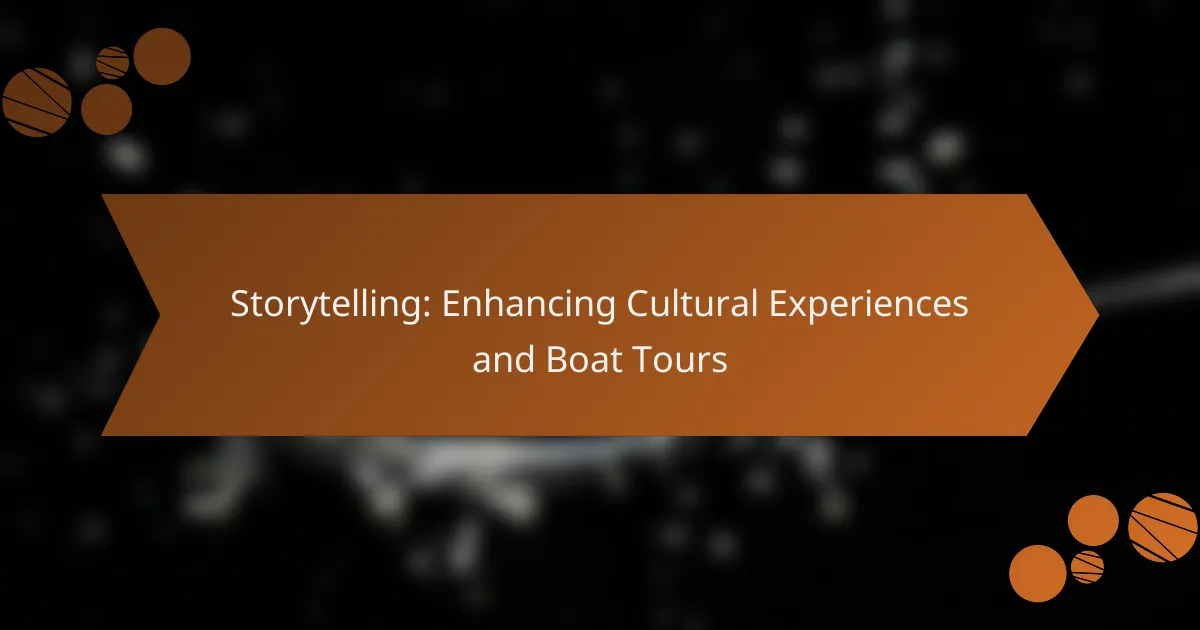Storytelling plays a vital role in enhancing cultural experiences during boat tours, allowing participants to forge a deeper connection with local heritage. By weaving engaging narratives about history, traditions, and unique characteristics of the area, these tours transform sightseeing into a memorable and meaningful journey.

How can storytelling enhance cultural experiences in boat tours?
Storytelling can significantly enhance cultural experiences in boat tours by creating a deeper connection between participants and the local heritage. Engaging narratives help to immerse tourists in the history, traditions, and unique characteristics of the area, making the experience more memorable and meaningful.
Immersive narratives
Immersive narratives draw participants into the story, allowing them to visualize and feel the history of the region. For instance, a boat tour in Venice might include tales of ancient merchants and their adventures, making the iconic canals come alive. This technique can transform a simple sightseeing trip into an engaging journey through time.
To create an immersive experience, guides should use vivid descriptions and relatable characters, encouraging participants to imagine themselves in the story. Incorporating sensory elements, such as sounds or smells associated with the narrative, can further enhance this immersion.
Local folklore integration
Integrating local folklore into boat tours enriches the experience by connecting tourists with the cultural roots of the area. For example, a tour in the Greek Islands could feature myths about gods and heroes, linking the landscape to its legendary past. This not only entertains but also educates participants about the cultural significance of the sites they visit.
When incorporating folklore, it’s essential to research and present stories authentically. Engaging local storytellers can provide unique insights and add credibility to the narratives, making the experience more genuine for participants.
Interactive audience engagement
Interactive audience engagement encourages participants to actively participate in the storytelling process, making the experience more dynamic. This can include asking questions, sharing personal stories, or even role-playing elements of the narrative. For instance, during a boat tour in the Amazon, guides might invite tourists to mimic local wildlife sounds or share their own travel tales.
To foster interaction, guides should create a welcoming atmosphere and encourage open dialogue. Simple techniques, such as using props or visual aids, can also enhance engagement and help participants connect with the story on a personal level.
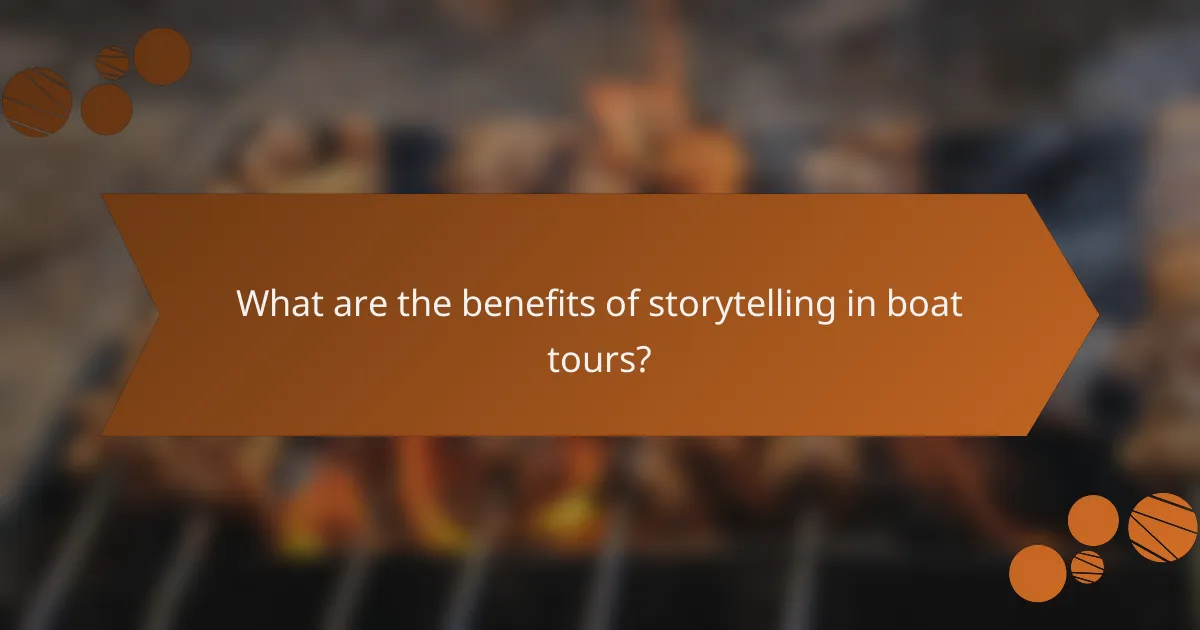
What are the benefits of storytelling in boat tours?
Storytelling in boat tours enhances the overall experience by engaging customers, creating memorable moments, and providing deeper insights into the culture and history of the area. This approach not only entertains but also fosters a connection between the tour guide and participants, enriching their understanding of the surroundings.
Increased customer satisfaction
Storytelling significantly boosts customer satisfaction during boat tours by making the experience more enjoyable and relatable. When guides share captivating stories about the local culture, history, or wildlife, participants are more likely to feel entertained and engaged, leading to positive feedback and repeat business.
To maximize satisfaction, tour operators should focus on tailoring stories to the interests of their audience. For instance, incorporating local legends or personal anecdotes can resonate well with tourists, enhancing their overall enjoyment.
Stronger emotional connections
Effective storytelling fosters stronger emotional connections between the tour guides and participants. When guides share personal stories or local folklore, it creates a sense of intimacy and trust, allowing guests to feel more connected to the experience and the destination.
To strengthen these connections, guides should encourage interaction by asking questions or inviting participants to share their own stories. This two-way communication can deepen the emotional impact of the tour, making it more memorable.
Enhanced educational value
Storytelling enhances the educational value of boat tours by providing context and meaning to the sights being observed. Instead of merely viewing landmarks, participants gain insights into their significance, which enriches their understanding of the area.
Tour operators can improve educational value by integrating storytelling with visual aids, such as maps or images, to illustrate historical events or cultural practices. This approach not only informs but also captivates the audience, making learning enjoyable and effective.
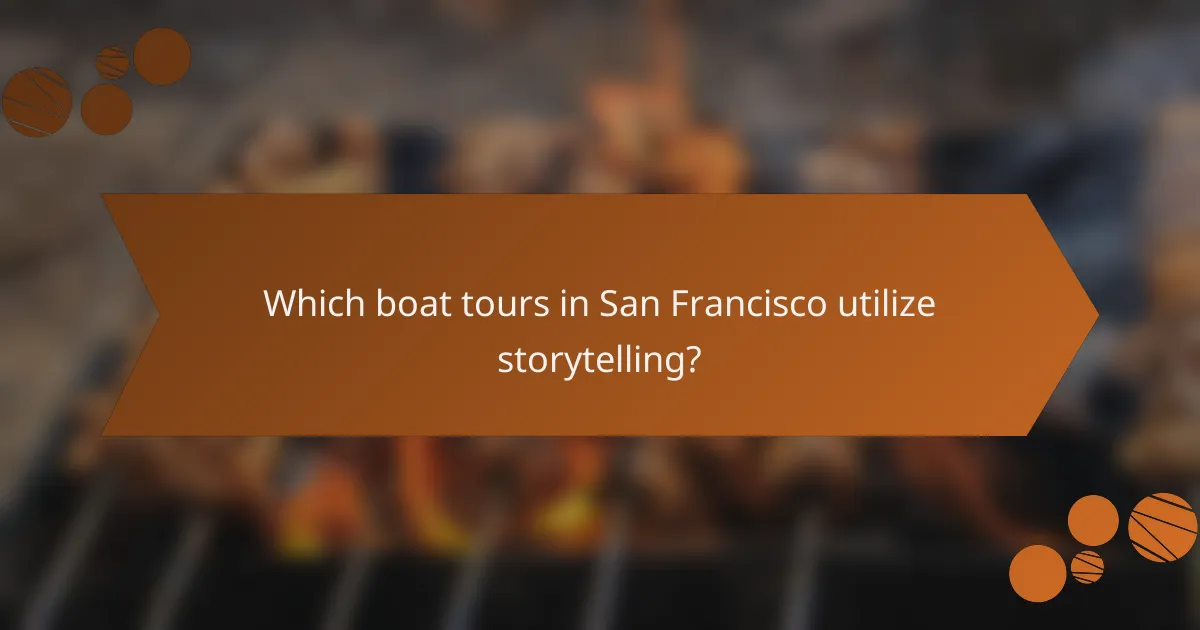
Which boat tours in San Francisco utilize storytelling?
Several boat tours in San Francisco incorporate storytelling to enhance the cultural experience for passengers. These tours often feature knowledgeable guides who share historical anecdotes, local legends, and insights about the landmarks visible from the water.
Blue & Gold Fleet
The Blue & Gold Fleet offers a range of tours that highlight San Francisco’s rich maritime history. Their narrated cruises include details about the Golden Gate Bridge, Alcatraz Island, and the city’s skyline, making the experience both informative and engaging.
Passengers can choose from various tour options, including the popular Bay Cruise, which lasts about an hour and provides a comprehensive overview of the bay’s attractions. The storytelling aspect is enhanced by the use of audio guides available in multiple languages.
San Francisco Bay Ferry
San Francisco Bay Ferry provides a unique blend of transportation and storytelling on its routes across the bay. While primarily serving commuters, the ferry experience includes informative commentary about the bay’s history and ecology, enriching the journey for both locals and tourists.
Ferries connect various points, such as Alameda and Oakland, to the city, allowing passengers to enjoy scenic views while learning about the area’s cultural significance. The storytelling is often spontaneous, depending on the crew’s knowledge and enthusiasm.
Red and White Fleet
The Red and White Fleet is known for its entertaining and educational cruises around San Francisco Bay. Their tours feature live narration that covers the history of the bay, its landmarks, and the stories behind them, making it a popular choice for families and tourists.
One of their signature offerings is the “Escape from the Rock” cruise, which focuses on the infamous Alcatraz prison. This tour combines historical storytelling with stunning views, creating a memorable experience for all ages.
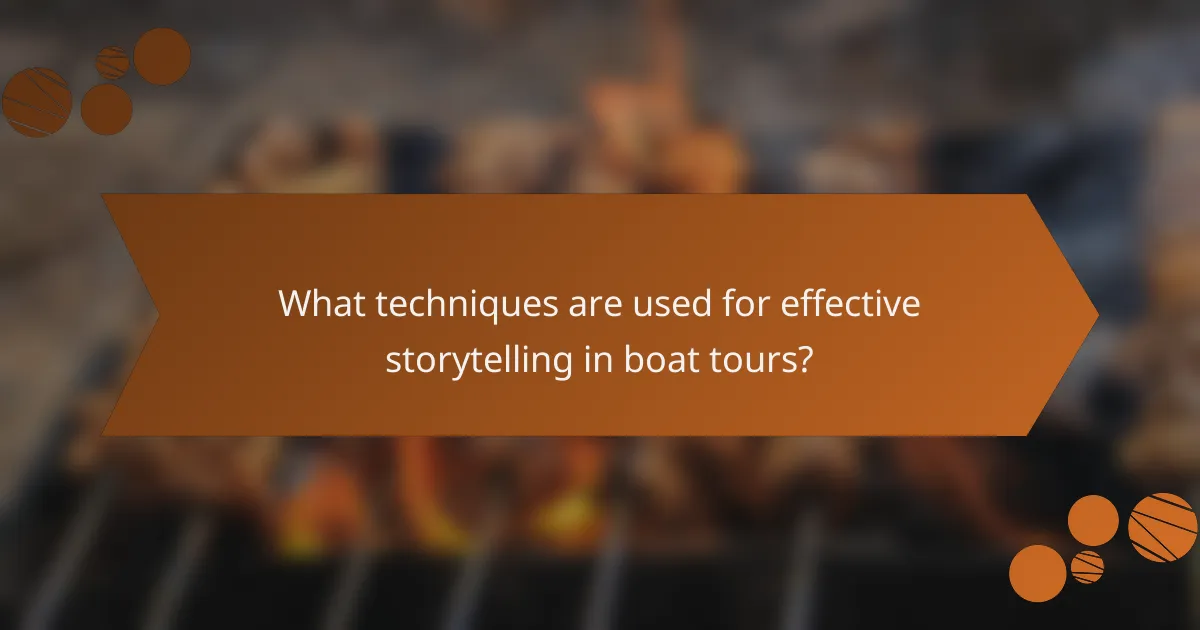
What techniques are used for effective storytelling in boat tours?
Effective storytelling in boat tours often employs a combination of visual aids, live narration, and soundscapes to create an engaging experience. These techniques enhance the cultural significance of the tour, making it memorable for participants.
Visual aids and props
Visual aids such as maps, photographs, and artifacts can significantly enhance storytelling during boat tours. They provide tangible connections to the narrative, helping participants visualize historical events or cultural anecdotes related to the locations visited.
Props can also be used to illustrate stories more vividly. For instance, a guide might use a replica of a historical artifact to explain its significance, allowing guests to engage with the story on a deeper level.
Live narration by guides
Live narration by knowledgeable guides is crucial for effective storytelling in boat tours. Guides can adapt their stories based on the audience’s reactions, creating a dynamic and interactive experience. This personalization helps maintain interest and engagement throughout the tour.
Additionally, guides can share local legends, historical facts, and personal anecdotes that enrich the narrative. Their enthusiasm and expertise can turn a simple boat ride into an unforgettable journey through culture and history.
Use of soundscapes
Incorporating soundscapes into boat tours can enhance the storytelling experience by immersing participants in the environment. Sounds of nature, local music, or historical recordings can evoke emotions and create a richer context for the stories being told.
For example, playing traditional music while passing by a culturally significant site can deepen the connection between the narrative and the location. This auditory element complements visual and verbal storytelling, making the overall experience more engaging and memorable.
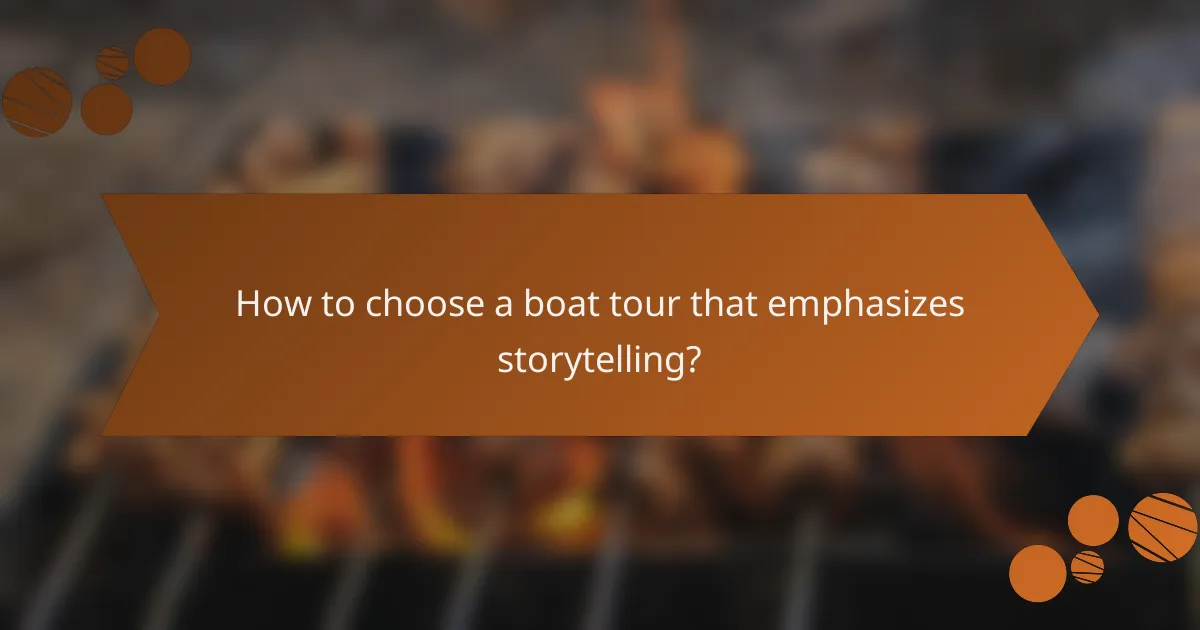
How to choose a boat tour that emphasizes storytelling?
Selecting a boat tour that focuses on storytelling involves evaluating the tour’s narrative quality, the expertise of the guides, and customer experiences. Look for tours that highlight cultural tales and local history to enrich your journey.
Research customer reviews
Customer reviews provide insights into the storytelling aspect of boat tours. Look for comments that specifically mention the quality of the narrative, engagement level of the guides, and overall experience.
Platforms like TripAdvisor or Yelp can be helpful. Aim for tours with a majority of positive reviews that highlight storytelling, as this often indicates a strong focus on narrative during the tour.
Check tour itineraries
Examine the itineraries of potential boat tours to see how they incorporate storytelling. Tours that include stops at historical sites or cultural landmarks typically offer richer narratives.
Look for descriptions that mention storytelling elements, such as local legends or historical anecdotes. A well-structured itinerary should balance sightseeing with engaging stories to enhance the experience.
Inquire about guide training
The training of the guides can significantly impact the storytelling quality during the tour. Ask about their background, experience, and any specific training in storytelling or local history.
Guides who have undergone specialized training often deliver more compelling narratives. Consider tours that emphasize their guides’ storytelling skills in their promotional materials.

What are the challenges of integrating storytelling in boat tours?
Integrating storytelling in boat tours presents challenges such as balancing narrative with factual information and engaging diverse audiences. Effective storytelling must resonate with participants while ensuring safety and compliance with local regulations.
Balancing entertainment and education
Boat tours often aim to educate passengers about local history, wildlife, or geography while providing an entertaining experience. Striking the right balance is crucial; too much focus on storytelling can detract from educational content, while excessive facts may bore guests. Tour operators should aim for a narrative that weaves in educational elements seamlessly.
Engaging diverse audiences
Boat tours attract a wide range of participants, including families, tourists, and locals, each with different interests and backgrounds. Crafting a story that appeals to all can be challenging. Operators should consider using universal themes or incorporating multiple perspectives to engage everyone on board.
Logistical constraints
Logistical issues, such as time limitations and varying weather conditions, can impact storytelling during boat tours. Operators must be adaptable, ready to modify their narratives based on the environment or time available. Having a flexible script and backup plans can help maintain engagement despite unforeseen circumstances.
Safety and compliance considerations
Safety regulations and compliance with local laws are paramount during boat tours. Storytelling should not compromise safety protocols or distract from emergency procedures. Operators should ensure that narratives are crafted in a way that allows for clear communication of safety information without losing the audience’s interest.
